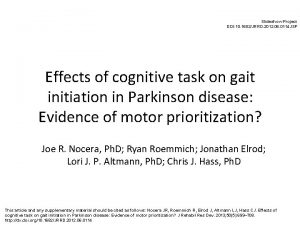Slideshow Project DOI 10 1682JRRD 2014 0114 JSP





- Slides: 5

Slideshow Project DOI: 10. 1682/JRRD. 2014. 0114 JSP Cross-sectional study of alteration of phantom limb pain with visceral stimulation in military personnel with ampuatation Michael Rafferty, MRCS; Thomas M. Bennett Britton, MRCGP; Benjamin T. Drew, MCSP; Rhodri D. Phillip, FRCP This article and any supplementary material should be cited as follows: Rafferty M, Bennett Britton TM, Drew BT, Phillip RD. Cross-sectional study of alteration of phantom limb pain with visceral stimulation in military personnel with amputation. J Rehabil Res Dev. 2015; 52(4): XX-XX. http: //dx. doi. org/10. 1682/JRRD. 2014. 0114

Slideshow Project DOI: 10. 1682/JRRD. 2014. 0114 JSP • Aim – Investigate the prevalence of the alteration in phantom limb pain intensity. • Relevance – Clinical experience suggests that the augmentation of phantom limb pain with visceral stimulation (sensation of the bowel or bladder either filling or evacuating) is an issue for many military personnel with amputation. This article and any supplementary material should be cited as follows: Rafferty M, Bennett Britton TM, Drew BT, Phillip RD. Cross-sectional study of alteration of phantom limb pain with visceral stimulation in military personnel with amputation. J Rehabil Res Dev. 2015; 52(4): XX-XX. http: //dx. doi. org/10. 1682/JRRD. 2014. 0114

Method Slideshow Project DOI: 10. 1682/JRRD. 2014. 0114 JSP • Cross-sectional study of 75 military personnel who have lost one or both lower limbs. • Participants completed questionnaire to assess the prevalence of the alteration of phantom limb pain with visceral stimulation. – Included visual analog scale (VAS) graded 0 to 10. – Recorded presence and intensity of phantom limb pain. – Recorded whether and how pain altered with a need to micturate or micturition, and/or a need to defecate or defecation. • Time since amputation, level of amputation, and medications also recorded. This article and any supplementary material should be cited as follows: Rafferty M, Bennett Britton TM, Drew BT, Phillip RD. Cross-sectional study of alteration of phantom limb pain with visceral stimulation in military personnel with amputation. J Rehabil Res Dev. 2015; 52(4): XX-XX. http: //dx. doi. org/10. 1682/JRRD. 2014. 0114

Results Slideshow Project DOI: 10. 1682/JRRD. 2014. 0114 JSP • Phantom limb pain prevalence of 85% with a mean VAS of 3. 6. • 56% reported a change in the severity of phantom limb pain with visceral stimuli. – Mean bladder stimulation VAS increase: 2. 5 ± 1. 6. – Mean bowel stimulation VAS increase: 2. 9 ± 2. 0. • 65% reported improvement in symptoms over time. • VAS scores highest in those less than 6 mo postamputation. This article and any supplementary material should be cited as follows: Rafferty M, Bennett Britton TM, Drew BT, Phillip RD. Cross-sectional study of alteration of phantom limb pain with visceral stimulation in military personnel with amputation. J Rehabil Res Dev. 2015; 52(4): XX-XX. http: //dx. doi. org/10. 1682/JRRD. 2014. 0114

Conclusion Slideshow Project DOI: 10. 1682/JRRD. 2014. 0114 JSP • An increase in phantom limb pain with visceral stimulation is a common problem for military personnel with amputation. This article and any supplementary material should be cited as follows: Rafferty M, Bennett Britton TM, Drew BT, Phillip RD. Cross-sectional study of alteration of phantom limb pain with visceral stimulation in military personnel with amputation. J Rehabil Res Dev. 2015; 52(4): XX-XX. http: //dx. doi. org/10. 1682/JRRD. 2014. 0114









